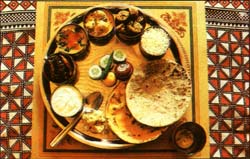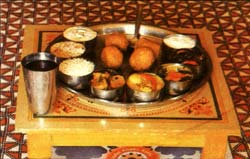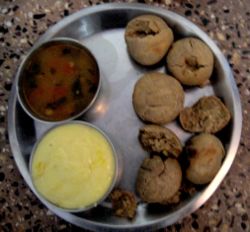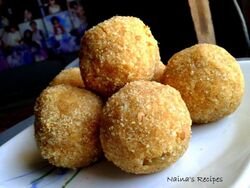Jat food habits


Jat food habits (जाटों का खानपान) are very simple. Jats are mostly non-meat eaters as a result of vedic and Buddhist influence. Their staple food is wheat or bajra, vegetables and plenty of milk and ghee. Jats cosider non-vege food undesirable but some of Jats started taking non-vege food after German war. Presently the proportion of meat eater Jats is very limited. Jat women are normally quite ignorant about cooking of non-vege dishes. Jats earlier were not in habit of taking wine but it is slowly growing in modern times due to influence of other societies.
Main food components
Milk, curd and ghee is the main food component of Jats. Almost all Jats keep domestic milking animals. On special occasions halua, kheer and chawal are prepared. Rice is consumed with a lot of ghee and sugar. Rabadi (राबड़ी) prepared from chhachh used to be very common dish in villages. Dal, churma, baati, lapsi, Gulgule and shakarpara are also very common. Papar and mangori are made from moong and moth which are used for vegetables through out the year. Jat habitations have a plenty of Kair tree and Khejri trees. The fruit of kair is used as vegetable and in making curry. Kair is used in pickles and used throuout the year. Khejri pods, called Saangri (सांगरी) in local language, are used as vegetables. Khichdi (also khichdee, khichadi, khichuri, khichari and many other variants) is an Indian dish that contains a combination of rice and lentils. Khichdi is commonly served with another Indian dish called "kadhi". Other common accompaniments are papads, beguni (deep fried eggplants in a besan batter), ghee (clarified butter), achar (oil based pickle), and yoghurt.
Baati (बाटी)

Baati (बाटी) is a hard, unleavened bread cooked in desert areas of Rajasthan, Malwa and Gujarat in North India. It is prized there for its exceptionally long life and high energy content, as well as the minimal quantity of water required in its preparation. It is always eaten with dal. Baati can have various kinds of fillings, including onions, peas, sattu, etc. Bafla and baati are always eaten with hot dal with loads of pure ghee and chatni. They are a must preparation when folks out there go out for picnic and prepare food at the spot.
Choorma (चूरमा)

Ingredients: Whole wheat flour 4 cups, Semolina 7 to 8 tabsp, ghee 3 cups and plus more for deep frying, Milk as per required for kneading, Castor sugar 2 cups or jaggery grated 2 1/2 cups. Cardamom powder 2 tsp, nutmeg 1 tsp, mixed chopped dry fruits and nuts 3/4 cup. 2 pinches of salt to make it tatsier.
Method: In a mixing bowl take the wheat flour, semolina salt and 1 cup of ghee. Knead the mixture with milk to make it a firm hard dough. Now make small balls out of this mixture and deep fry on medium heat in ghee. Fry till it becomes golden and lite. Now let it cool and transfer it into a blender and grind it coarsely. Now tranfer this Choorma into a bowl and add the sugar or jaggery, cardamom powder, nutmeg powder, 2 cups of ghee and the chopped fruits and nuts. Make small laddu’s out of this mixture. Enjoy the wholesome goodness of wheat semolina jaggery and nuts.
Choorma can eaten with hot' dal or Kheer as well.
Kheer (खीर)
Kheer is a traditional dish in the Indian subcontinent, a rice pudding typically made by boiling rice with milk and sugar. It is often flavored with cardamoms and pistachios. Kheer is from Sanskrit word "Ksheer" which means Milk. It is an essential dish in many Hindu and Muslim feasts and celebrations in South Asia. While the dish is traditionally made with rice, it can also be made with other ingredients such as vermicelli (semiya). The recipe for the popular English rice pudding was, in fact, derived from kheer when Britain had occupied India. Ultimately, kheer can be traced back to an ancient dish from Puri. The north Indian version of rice kheer most likely originated in the temple city of Puri, in Orissa about two thousand years ago. It is cooked to this day within the Jagannath temple precincts there. Every single day, hundreds of temple cooks work around 752 hearths in what is supposed to be the world's largest kitchen (over 2500 sq. ft) to cook over 100 different dishes, including kheer, enough to feed at least 10,000 people. Traditionally the Oriya version of kheer is sprinkled with fried cashews and raisins and served in most festive occasions, such as weddings, birthdays, and religious festivals. Although white sugar is most commonly used, adding gur (molasses) made of dates as the sweetener is an interesting variation that is also relished in Orissa. In Nepal, on the fourth month of the solar calendar, it is a tradition to eat Kheer. The dish is also consumed at Muslim weddings and prepared on the feasts of Eid ul-Fitr and Eid ul-Adha.
Chhachh (छाछ)
Chhachh (छाछ) or Mattha (मटठा) is an Indian drink made from curd or yogurt. Other ingredients include mint, salt, sugar, and namkeen (made from gram flour). It is generally served before or after a meal, though it can also be drunk with the meal, and it is thought to help with digestion.
Curd and Bajra Roti

दही प्राय हर जाट परिवार में मिलता है। आम-तौर पर सुबह दही और बाजरे की रोटी का नासता बहुत जल्दी से तैयार हो जाता है। दही में भूना हुआ जीरा और टेस्ट के अनुसार नमक मिलाओ। उसमें बाजरे की रोटी चूर कर खाओ। जहां बाजरा नहीं खाया जाता है वहाँ गेहूं अथवा मक्का की रोटी का प्रयोग भी किया जा सकता है।
Bathue ka Raita
Ingredients: Bathua bunch 1 Big, Cumin seeds 2 teaspoons,Yogurt 2 cups,Salt to taste, Black pepper powder 1/4 teaspoon, Red chilli powder 1/2 teaspoon
Method:
Step 1: Clean and wash bathua leaves thoroughly. Blanch them in two cups of water for two to three minutes. Drain, cool and grind coarsely. Dry roast cumin seeds and grind to a fine powder.
Step 2: Whisk yogurt with salt, pepper powder, half the roasted cumin seed powder and half the red chilli powder. Add the ground bathua and mix well.
Step 3: Transfer into a serving dish, garnish with the remaining roasted cumin seed powder and red chilli powder and serve chilled.
Ganne ke ras ki Kheer
See Video - Ganne ke ras ki Kheer at post-2
गर्मी का पेय राबड़ी[1]
राबड़ी जाटों का मुख्य पेय है. राबड़ी कोई बियर का नया ब्रांड नही है. ये एक अमृत है गर्मी से निजाद पाने के लिए. राबड़ी राजस्थान और हरयाणा का प्रमुख पेय है जो कि काफी लोकप्रिय और सस्ता भी है और स्थानीय रूप से आसानी से तैयार हो जाता है. राजस्थन में जहा 45-50 डिग्री तापमान रह्ता है वहां ये वरदान है. लू के थपेड़ों में भी लोग इसको पी कर दोपहर में आराम से सोते है. यह गरमी के मौसम में अधिक प्रयोग की जाती है. जो पहली बार राबड़ी पिएगा, एक गिलास मे बेहोश नींद में सो जाएगा. आजकल राबड़ी पाँच सितारा होटलों मे भी उपलब्ध है और विदेशी पर्यटक बड़े चाव से राबड़ी का लुत्फ उठा रहे है. इस राबडी के साथ बाजरे की रोटी चूर कर खा सकते हैं या ठंडी राबडी में छाछ या दही और जीरा मिलाकर पी सकते हैं.
राबड़ी के फायदे ही फायदे हैं:-
- यह तनाव कम कम करती
- इससे नींद अच्छी आती है
- कभी लू नही लगती है
- ब्लड प्रेशर नही होता है
- अस्थमा में भी लाभदायक है
- भूक अच्छी लगती है
- पेट की हर बिमारी में लाभ दायक है
- यह पथरी रोग ठीक करती है
राबड़ी बनाने की विधि
राबड़ी तीन प्रकार की होती है.
- खाटे की राबड़ी
- छाछ की राबड़ी
- कुटेड़ी राबड़ी
खाटे की राबड़ी
यह राबड़ी बनाने के लिए २०० ग्राम बाजरे के आटे में ५० ग्राम मोठ का आटा मिलाएँ तथा लगभग २५० ग्राम छाछ में मिट्टी की हांडी में पाँच मिनट तक हाथ से फेंटें. इसमें ५ लीटर हलका गुनगुना पानी मिलाएं. इस घोळ को दोपहर को धूप में रखें. साम ५ बजे तक इसमें खमीर आ जाता है तब इसका पानी कपड़े से छानलें. नीचे जमा आटा अलग रख लें. निथारे पानी को आग पर चढा कर स्वाद के अनुसार नमक डालें. पानी जब उबलने लगे तब अलग रखे आटे को उबलते पानी में डाल कर लगभग २-४ मिनट पकाएं और साथ साथ लकडी के चाटू से हिलाते रहें ताकि गठान न पडें. इसमें दो-तीन उफान आजायें तब गाढ़ी होने पर उतार लें. यदि ज्यादा गाढ़ी हो जाए तो थोड़ा छाछ मिला लें . राबडी तैयार. अगर बाजरे का आटा या मोठ नही मिले तो गेंहू का आटा भी चल सकता है पर जो मजा बाजरे और मोठ के आटे की राबडी में है वो नही मिलेगा.
छाछ की राबड़ी
एक लीटर छाछ में लगभग २०० ग्राम बाजरे का आटा मिलाकर आग पर चढावें और धीरे धीरे लकड़ी के चाटू से हिलाते रहें. जब यह गाढी हो जाए और उफनने लगे तब नीचे उतार कर स्वाद के अनुसार नमक मिलावें. यदि गाढी ज्य्य्यादा हो जाए तो इसमें ठंडा छाछ और मिलावें. यह राबडी प्राय शर्दी के मौसम में खाई जाती है. साम को गरम गरम खाई जाती है और सुबह इसमे ठंडी में दही मिलाकर बाजरे की रोटी के साथ खाया जाता है.
कुटेड़ी राबडी
एक लीटर छाछ के लिए २०० ग्राम साबूत बाजरा भिगोयें. ३ घंटे बाद चलनी से पानी निकाल कर ओखली में मूसल से बाजरा कूटें. कूटने से बाजरा जब सफ़ेद दिखने लगे और आधा फूट जाए तो एक लीटर छाछ में लगभग २०० ग्राम कूटे बाजरे को मिलाकर आग पर चढावें और धीरे धीरे लकड़ी के चाटू से हिलाते रहें. जब यह गाढी हो जाए और उफनने लगे तब नीचे उतार कर स्वाद के अनुसार नमक मिलावें. यदि गाढी ज्यादा हो जाए तो इसमें ठंडा छाछ और मिलावें. यह राबडी प्राय शर्दी के मौसम में खाई जाती है. साम को गरम गरम खाई जाती है और सुबह इसमे ठंडी में दही मिलाकर बाजरे की रोटी के साथ खाया जाता है. साम को गरम गरम खाई जाती है और सुबह इसमे ठंडी में दही मिलाकर बाजरे की रोटी के साथ खाया जाता है.
खिचड़ी [2]
जाट लोग मोठ और बाजरे की खिचडी खाते हैं. एक हांडी में चार लीटर पानी चढाओ. २५० ग्राम बाजरा ४ घंटे पहले भिगोदो. बाजरे को ओखली में कूटलो. २५० ग्राम मोठ की दाल लो. स्वाद के अनुसार नमक मिलाओ. अब पानी को उबालो. जब पानी उबल जाए तो यह सामन उबलते पानी में डाल दो और लकडी के चाटू से धीरे धीरे हिलाओ. इसको धीमी आग में पकाओ और बीच बीच में हिलाते जाओ ताकि नीचे न जम जाए. दाने देखो यदि पक गए हैं और गाढ़ी हो गयी है तो खिचडी तैयार. खिचडी को कढी के साथ या दूध के साथ या घी और बुरा डाल कर खा सकते हैं.
जड़ी बूटी के लड्डू [3]
जड़ी बूटी के लड्डू प्राय: शर्दी में खाए जाते हैं. ये कमर दर्द, अम्लता, कमजोरी आदि दूर करते हैं. रक्तदाब को नियंत्रित करते हैं. डिलीवरी के बाद खाने वाली महिलाएं जल्दी स्वस्थ होती हैं. इसकी विधि इस प्रकार है:
सामग्री -
- आधा किलो अजवायन,
- एक पाव सूंठ,
- 200 ग्राम सफ़ेद मूसली,
- एक किलो छूँवारा,
- 200 ग्राम मखाना,
- दो नारियल गोला,
- एक पाव बड़ी इलायची,
- 200 ग्राम कमरकस (लाल) गोंद,
- 100 ग्राम हल्दी,
- 100 ग्राम काली मिर्च,
- 200 ग्राम छोटी इलायची,
- 100 ग्राम खस-खस,
- 500 ग्राम सामान्य गोंद,
- दो किलो गुड़ या चीनी,
- दो किलो गेहूं का मोटा आटा,
- दो किलो गाय का घी,
- 25 ग्राम केसर,
- आधा किलो सिंघाड़े का आटा
- जायफल 2 नाग
- 250 ग्राम अर्जुन की छाल
- 25 ग्राम लोंग
विधि - सोंठ, अजवायन, छूँवारा, सफ़ेद मूसली को साफ़ पानी से धोकर कपडे पर फैलाकर पंखे के नीचे दो दिन छाया में सुखालें. नारियल को किसकर थोडासा घी डालकर उसमें फ्राई कर लें ताकि रंग हल्का भूरा हो जाये. छूंवारे के टुकड़े कर घी में फ्राई कर लें. बड़ी इलायची, काली मिर्च, मखाना और सफ़ेद मूसली को भी अलग-अलग फ्राई कर लें. सादे गोंद को घी में गर्म कर फुलालें. कमर कस को बारीक पीसलें. खस-खस को एक चम्मच घी डालकर कड़ाही में हल्का सा सेक लें. हल्दी, खस-खस और केसर को छोड़कर बाकी उपरोक्त सब सामग्रियों को बारीक पीसलें और पावडर बनालें. दो किलो घी में दो किलो आटा भूंज लें ताकि इसका रंग भूरा हो जाये. जाय फल बारीक पीसलें. अर्जुनछाल को कूट कर छानकर बारीक पावडर बनालें. लोंग को गर्म घी में सेक लें और पीसलें. अब सभी सामग्रियों को गर्म आटे में मिलालें. इसमें गुड़ या चीनी मिलालें. ज्यादा मीठा खाना हो तो आधा किलो गुड़ या चीनी और मिलालें. अब इसके लड्डू बनालें.
रोज सुबह या शाम या दोनों समय एक-एक लड्डू खालें और दूध पीलें.
परहेज - इन लड्डुओं के साथ ज्यादा खट्टी चीजें जैसे आचार, ईमली अदि का परहेज करें.
Fruits and vegetables
वैसे तो जाट सभी फल खाते हैं परन्तु स्थानीय उपलब्ध फलों की अलग ही उपयोगिता है. राजस्थान के अधिकांश जाट प्रकृति में उपलब्ध फलों को सुखा कर उनका उपयोग साल भर करते हैं. इनमें से एक फल बेर है. यह बहुतायत से मरुस्थल में पाया जाता है. वर्षात की फसल पकने के साथ ही झाड़ियों के बेर भी पकते हैं. इनको झाड़ कर सुखा लेते हैं.फिर शर्दी और गर्मी तक इनका लुत्फ़ उठाया जा सकता है.
सन्दर्भ
External links
Back to Jat food habits

